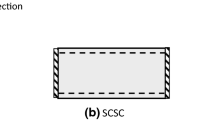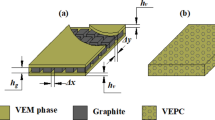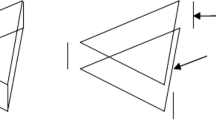Abstract
The study aims at vibration control of laminated plates by the active constraining layer damping (ACLD) treatment incorporating the Murakami zig-zag function (MZZF) while deriving the displacement fields. The control is achieved by activating the ACLD patches by supplying the control voltage. The ACLD patch has two component layers, namely 1–3 piezoelectric composite (PZC) constraining material layer and the viscoelastic constrained material layer. The complete ACLD plate system is modelled as a three layered structure using a MZZF in the displacement fields of the individual layers, and the FE model is obtained by the virtual work principle. A MATLAB FE code has been developed considering the closed loop feedback system for the control of the input parameters. The present method of modelling the ACLD system has proven to be accurate and cost effective for damping the vibrations of the composite plates. Also, the change in piezo fiber orientation angle on the control and performance of the ACLD patches has been effectively studied in detail.













Similar content being viewed by others
References
Bailey, T., Ubbard, J.E.: Distributed piezoelectric-polymer active vibration control of a cantilever beam. J. Guid. Control Dyn. 8, 605–611 (1985)
Baz, A., Ro, J.: Performance characteristics of active constrained layer damping. Shock Vib. 2, 33–42 (1995)
Brischetto, S., Carrera, E., Demasi, L.: Improved response of unsymmetrically laminated sandwich plates by using zig-zag functions. J. Sandw. Struct. Mater. 11, 257–267 (2009a)
Brischetto, S., Carrera, E., Demasi, L.: Improved bending analysis of sandwich plates using a zig-zag function. Compos. Struct. 89, 408–415 (2009b)
Carrera, E.: C0 Reissner–Mindlin multilayered plate elements including zig-zag and interlaminar stress continuity. Int. J. Numer. Methods Eng. 39, 1797–1820 (1996)
Carrera, E.: C0z requirements-models for the two dimensional analysis of multilayered structures. Compos. Struct. 37, 373–383 (1997)
Carrera, E.: An assessment of mixed and classical theories on global and local response of multilayered orthotropic plates. Compos. Struct. 50, 183–198 (2000)
Carrera, E.: On the use of the Murakami’s zig-zag function in the modeling of layered plates and shells. Comput. Struct. 82, 541–554 (2004)
Carrera, E., Ciuffreda, A.: A unified formulation to assess theories of multilayered plates for various bending problems. Compos. Struct. 69, 271–293 (2005)
Dunn, M.L., Taya, M.: Micromechanics predictions of the effective electroelastic moduli of piezoelectric composites. Int. J. Solids Struct. 30, 161–175 (1993)
Kumar, R.S., Ray, M.C.: Smart damping of geometrically nonlinear vibrations of functionally graded sandwich plates using 1–3 piezoelectric composites. Mech. Adv. Mater. Struct. 23, 652–669 (2016)
Lo, K.H., Christensen, R.M., Wu, E.M.: A high-order theory of plate deformation part 2: laminated plates. J. Appl. Mech. 44, 669–676 (1977)
Murakami, H.: Laminated composite plate theory with improved in-plane responses. J. Appl. Mech. 53, 661–666 (1986)
Pagano, N.J., Hatfield, S.J.: Elastic behavior of multilayered bidirectional composites. AIAA J. 10, 931–933 (1972)
Panda, S., Ray, M.C.: Nonlinear finite element analysis of functionally graded plates integrated with patches of piezoelectric fiber reinforced composite. Finite Elem. Anal. Des. 44, 493–504 (2008)
Piezocomposites, Materials Systems Inc., 543 Great Road, Littleton, MA 01460
Ray, M.C.: Micromechanics of piezoelectric composites with improved effective piezoelectric constant. Int. J. Mech. Mater. Des. 3, 361–371 (2006)
Ray, M.C., Baz, A.: Optimization of energy dissipation of active constrained layer damping treatments of plates. J. Sound Vib. 208, 391–406 (1997)
Ray, M.C., Bhattacharya, R.: Static analysis of an intelligent structure. Comput. Struct. 52, 617–631 (1994)
Ray, M.C., Faye, A.: Active structural-acoustic control of laminated composite plates using vertically/obliquely reinforced 1–3 piezoelectric composite patch. Int. J. Mech. Mater. Des. 5, 123–141 (2009)
Ray, M.C., Mallik, N.: Active control of laminated composite beams using a piezoelectric fiber reinforced composite layer. Smart Mater. Struct. 13, 146–152 (2004)
Ray, M.C., Pradhan, A.K.: The performance of vertically reinforced 1–3 piezoelectric composites in active damping of smart structures. Smart Mater. Struct. 15, 631–641 (2006)
Ray, M.C., Pradhan, A.K.: On the use of vertically reinforced 1–3 piezoelectric composites for hybrid damping of laminated composite plates. Mech. Adv. Mater. Struct. 14, 245–261 (2007)
Ray, M.C., Rao, K.M.: Exact analysis of coupled electroelastic. Comput. Struct. 45, 667–677 (1992)
Ray, M.C., Reddy, J.N.: Active control of laminated cylindrical shells using piezoelectric fiber reinforced composites. Compos. Sci. Technol. 65, 1226–1236 (2005)
Ray, M.C., Rao, K.M., Samanta, B.: Exact solution for static analysis of an intelligent structure under cylindrical bending. Comput. Struct. 47, 1031–1042 (1993)
Ray, M.C., Bhattacharya, R., Samanta, B.: Exact solutions for dynamic analysis of composite plates with distributed piezoelectric layers. Comput. Struct. 66, 737–743 (1998)
Reddy, J.N.: A simple higher-order theory for laminated composite plates. J. Appl. Mech. 51, 745 (1984)
Reddy, J.N.: Mechanics of Laminated Composite Plates, Theory and Analysis. CRC Press, Boca Raton (1997)
Reddy, J.N.: On laminated composite plates with integrated sensors and actuators. Eng. Struct. 21, 568–593 (1999)
Reddy, B.A., Ray, M.C.: Optimal control of smart functionally graded plates using piezoelectric fiber reinforced composites. J. Vib. Control 13, 795–814 (2007)
Sahoo, S.R., Ray, M.C.: Analysis of smart damping of laminated composite beams using mesh free method. Int. J. Mech. Mater. Des. 14, 359–374 (2017)
Sarangi, S.K., Ray, M.C.: Active damping of geometrically nonlinear vibrations of laminated composite shallow shells using vertically/obliquely reinforced 1–3 piezoelectric composites. Int. J. Mech. Mater. Des. 7, 29–44 (2011a)
Sarangi, S.K., Ray, M.C.: Active damping of geometrically nonlinear vibrations of laminated composite plates using vertically reinforced 1–3 piezoelectric composites. Acta Mech. 222, 363–380 (2011b)
Smith, W.A., Auld, B.A.: Modeling 1–3 composite piezoelectrics: thickness-mode oscillations. IEEE Trans. Ultrason. Ferroelectr. Freq. Control 38, 40–47 (1991)
Suresh Kumar, R., Ray, M.C.: Active constrained layer damping of smart laminated composite sandwich plates using 1–3 piezoelectric composites. Int. J. Mech. Mater. Des. 8, 197–218 (2012)
Whitney, J.M., Pagano, N.J.: Shear deformation in heterogeneous anisotropic plates. J. Appl. Mech. 37, 1031–1036 (1970)
Author information
Authors and Affiliations
Corresponding author
Additional information
Publisher's Note
Springer Nature remains neutral with regard to jurisdictional claims in published maps and institutional affiliations.
Appendix
Appendix
The matrices \(\left[{Z}_{1}\right], \left[{Z}_{2}\right], \left[{Z}_{3}\right], \left[{Z}_{4}\right], \left[{Z}_{5}\right],\mathrm{and} \left[{Z}_{6}\right]\) found in Eqs. (7) and (8) are given by
where \(\left[ {\overline{Z}_{1} } \right]_{k = 1 to N} = \left[ {\overline{Z}_{2} } \right]_{k = N + 1} = \left[ {\overline{Z}_{1} } \right]_{k = N + 2} = \left[ {\begin{array}{*{20}c} z & 0 & 0 & 0 \\ 0 & z & 0 & 0 \\ 0 & 0 & z & 0 \\ 0 & 0 & 0 & 1 \\ \end{array} } \right]\).
The submatrices \(\left[{B}_{tbj}\right]\), \(\left[{B}_{rbj}\right]\), \(\left[{B}_{tsj}\right]\) and \(\left[{B}_{rsj}\right]\) found in Eq. (22) are as follows:
While, the rigidity matrices, coupling electro-elastic rigidity vectors pertaining to 1–3 PZC material found in Eq. (29) are explicitly given as
Rights and permissions
About this article
Cite this article
Khan, N.M., Suresh Kumar, R. Smart control of laminated plates using Murakami zig-zag functions. Int J Mech Mater Des 17, 463–487 (2021). https://doi.org/10.1007/s10999-021-09542-0
Received:
Accepted:
Published:
Issue Date:
DOI: https://doi.org/10.1007/s10999-021-09542-0




